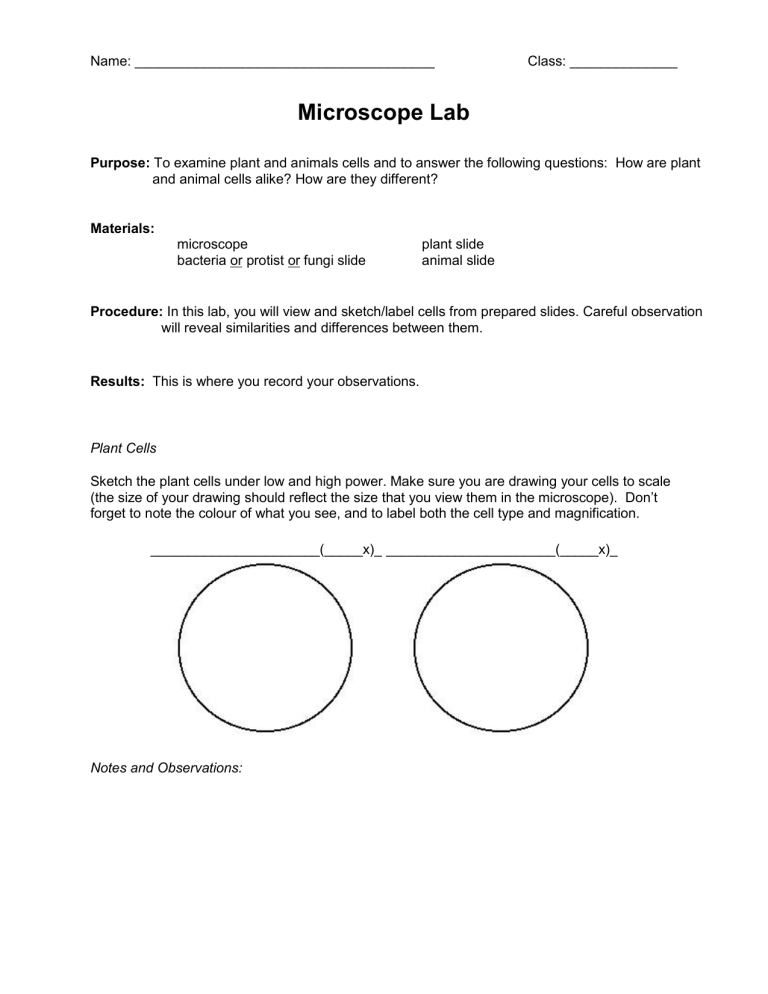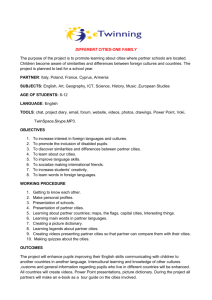Microscope Lab
advertisement

Name: _______________________________________ Class: ______________ Microscope Lab Purpose: To examine plant and animals cells and to answer the following questions: How are plant and animal cells alike? How are they different? Materials: microscope bacteria or protist or fungi slide plant slide animal slide Procedure: In this lab, you will view and sketch/label cells from prepared slides. Careful observation will reveal similarities and differences between them. Results: This is where you record your observations. Plant Cells Sketch the plant cells under low and high power. Make sure you are drawing your cells to scale (the size of your drawing should reflect the size that you view them in the microscope). Don’t forget to note the colour of what you see, and to label both the cell type and magnification. ______________________(_____x)_ ______________________(_____x)_ Notes and Observations: Animal Cells Sketch your animal cells under low and high power, also paying attention to scale. Don’t forget to note the colour of what you see, and to label both the cell type and magnification. ______________________(_____x)_ ______________________(_____x)_ Notes and Observations: Student Choice Sketch your chosen cells under low and high power, also paying attention to scale. Don’t forget to note the colour of what you see, and to label both the cell type and magnification. ______________________(_____x)_ ______________________(_____x)_ Notes and Observations: Discussion: This is where you analyze your results. 1. What are the differences between the plant and animal cells? 2. What are the similarities between the plant and animal cells? 3. Compare your plant cells to those of another group. Are the similarities and differences what you expected? Why or why not? 4. Compare your animal cells to those of another group. Are the similarities and differences what you expected? Why or why not? 5. Why does your chosen specimen not fit within either the plant or animal groups? Students will be assessed on the following categories. Code E C A 2-2 In their work, pupils use equipment in a safe and basically functional way. In their work, pupils use equipment in a safe and appropriate way. In their work, pupils use equipment in a safe, appropriate and effective way. 2-3 Pupils can compare their own results with those of others and apply simple reasoning about similarities and differences and what these may be related to, and also contribute to making proposals that can improve the study. Pupils can compare their own results with those of others and apply developed reasoning to similarities and differences, and what these may be due to, and also make proposals which after some reworking can improve the study. Pupils can compare their own results with those of others and apply well developed reasoning to similarities and differences, and what these may be due to, and also make proposals which can improve the study. 2-4 In addition, pupils draw up simple documentation of their studies using text and pictures. In addition, pupils draw up developed documentation of their studies using texts and pictures. In addition, pupils draw up well developed documentation of their studies using text and pictures.





